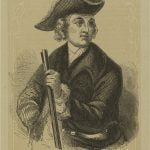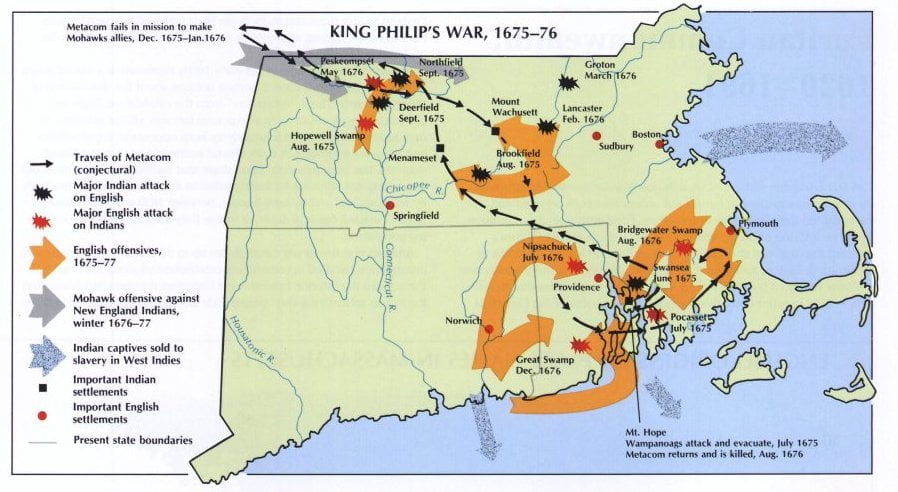Captain Benjamin Church

He found the queen leading the dance, “in a muck of sweat,” surrounded by a great body of her subjects. She received her visitor hospitably, told him of Philip’s threats, and inquired concerning the purposes of the English. Church told her that no injuries had been meditated by the whites, as Philip averred, but that the sachem was the aggressor. He advised her to keep upon good terms with the English, asking her whether it was a probable thing that he should have come down into the wilderness to settle, if there were warlike preparations in progress among his people; and silenced the six Mount Hope ambassadors by recommending that they should be knocked on the head. A stormy discussion ensued among the Indians, and one Little Eyes, a man of importance, endeavored to draw Church aside to dispatch him quietly; but the captain was unmoved, and upbraided the Mount Hopes for their bloody intention, assuring them that, if they would have war, he would prove a thorn in their sides. Awoshonks inclined to his advice, and, having appointed two men to guard his house during his absence, desired him to go to Plymouth, and make known her good faith to the colonies.
Church started on his mission, and, on the way, gained further information concerning Philip’s movements from Peter Nunnuit, the husband of Weetamore, queen of Pocasset, now Tiverton. Philip, it seems, had been holding a protracted dance for a number of weeks, rousing a martial spirit in the minds of the young warriors who were gathered about him from far and near. He had finally promised them that, on the succeeding Sabbath, they might plunder the English settlements, while the people were engaged in religious services.
Murder Of John Sassamon
We may here mention a circumstance which was considered, by Hubbard and others, as having an important bearing upon the premature commencement of hostilities on the part of Philip: this was the murder of John Sassamon, and the subsequent execution of the guilty parties. Sassamon was one of the few Indians who, at that time, had received the rudiments of an English education. He was a professor of Christianity, and had been employed among his people in the capacities of schoolmaster, preacher, and royal secretary. In 1662, he occupied this latter post under Philip, to whom he was subject, although born a Massachusett and specimens of his imperfect communications with the colonies, in behalf of his sachem, are still preserved.
Becoming aware of the dangerous conspiracy fomented by Philip, he disclosed the whole plot to the officers of the colony; and, not long after, his body was found in Assawomsett pond, with the neck broken, and presenting other marks of violence. His gun and hat were so disposed as to give the impression that he had accidentally fallen through the ice, and been drowned. The matter was strictly inquired into, and three Indians, of Philip s party, falling under suspicion, were regularly tried before a jury, in part at least of their peers, as it was composed of whites and Indians. The culprits were convicted and executed, two of them upon what would appear to us as very insufficient evidence. Mather speaks of the blood oozing from the murdered body on the approach of the accused; but whether this circumstance made a part of the evidence before the court does not appear.
Philip himself did not come forward to attempt to clear himself of the charge of being concerned in this murder, but kept his warriors in preparation for battle, receiving and entertaining all the roving and unsettled Indians who would resort to him, and “matching up and down” continually during the pendency of the trial.
Attack on Swansey
It was on the 24th of June 1675, that the first open attack was made upon the colonies. The small village of Swansey lay within a few miles of Mount Hope, and here the first blood was shed. Some days previous, a party of the natives had committed a few slight depredations at this place, and conducted themselves with insolence, evidently desirous of provoking a quarrel.
The squaws and children of Philip’s active force were sent, for safety, to the country of the Narragansetts, before any open demonstration of hostilities.
Some little discrepancy occurs in the early accounts of the first fatal attack, but it is certain that, on the day above mentioned, eight or nine men were killed in different parts of Swansey. A company returning from religious exercises, “in a way of humiliation,” were fired upon with fatal effect, one being killed and several wounded. Two more, who had started in quest of a surgeon, were slain, scalped and mangled; and six men were killed at a dwelling house situated in another part of the settlement.
From this period all was terror and confusion. Swansey was deserted by its inhabitants, and mostly reduced to ashes by the Indians. Deputations were sent to Boston, to lay the case before the Massachusetts authorities, and to solicit some prompt and efficient protection in this terrible emergency.
A party of horse and foot were at once dispatched in the direction of Mount Hope, under the command of Captains Henchman and Prentice. Samuel Mosely, a bold and martial character, who had pursued the calling of a privateer, raised a volunteer company of one hundred and ten soldiers, and joined the expedition. He was, it is said, accompanied by several buccaneers of his own class, with a number of dogs; and the feats performed by them, upon divers occasions, savor rather of the marvelous.
Fight At Miles Bridge
The head-quarters of the united forces were at the house of a minister of Swansey, named Miles, and hard by was a bridge, affording convenient access to the domains of Philip.
Captain Church, with the Plymouth troops under Major Cutworth, were now acting in concert with the men from Massachusetts. The Indians lay concealed or skulking about the garrison, and succeeded in killing a number by shots from covert, but showed themselves wary of coming to open combat.
A detachment of Prentice s men, led by a Mr. Gill and one Belcher, made an attempt upon the enemy in their own quarters, but, upon crossing Miles bridge, were fired upon by some of the Indians lying in ambush, and one of their number was killed. Gill was struck by a ball, which would have proved mortal but for a singular species of defensive armor, viz.: a quantity of thick brown paper, which he had inserted under his clothes. The troops re treated, leaving Church, Gill, and another to bring off the dead man; which, being accomplished, Church pursued and regained his horse, under the full fire of the enemy.
The next day the bridge was crossed by a larger force, and, after some skirmishing, in which “Ensign Savage, that young martial spark, scarce twenty years of age,” was shot through the thigh as Church says, by an accidental ball from his own party the neck of Mount Hope was cleared of Indians. The English there found Philip s deserted wigwam, and the mutilated remains of a number of the murdered whites.
It was now proposed to secure the ground already gained by the erection of a fort. Church ridiculed the plan, and urgently advocated a brisk pursuit of the enemy in the Pocasset country, whither they had doubtless fled. From disregard to this advice, Philip had free scope to extend his devastation unchecked toward the east, and terrible destruction ensued, as we shall see hereafter.
Early in July, Captains Church and Fuller, with six files of soldiers, were sent across to Rhode Island, thence to cross Sogkonate River, and endeavor to communicate with the Pocasset and Sogkonate Indians. About the same time, Captain Hutchinson, from Boston, arrived at the English encampment, having been commissioned to treat with and gain over the Narragansetts. In pursuance of this purpose, Hutchinson, with Mosely and the Massachusetts troops, proceeded in arms to the Narragansett country, where, in concert with commissioners from Connecticut, they concluded a futile and inoperative treaty of amity with certain Indians claiming to be chief counselors of the prominent sachems. The Narragansetts were bound, by the stipulations of this alliance, to render up all of Philip s subjects who should be found in their country receiving two coats for every prisoner, and one coat for every head and to carry on active war against the enemies of the whites. Hostages were given to ensure the performance of the engagement.
While this child’s play was enacting, Fuller and Church, with their little band of thirty-six men, had penetrated into the country of the Pocassets. After some unsuccessful attempts to entrap the enemy by means of ambuscade, (the concealed company being betrayed by incautiously gratifying their “epidemical plague, lust after tobacco,”) Church and fifteen or twenty companions, with the consent of Captain Fuller, left the rest at Pocasset, and marched southward.


